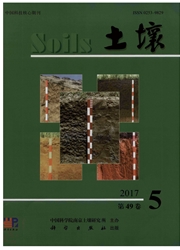

 中文摘要:
中文摘要:
以荣成天鹅湖这一天然泻湖为研究对象,研究了6个样点沉积物对磷的吸附动力学曲线和等温吸附方程,并分析了沉积物理化性质与磷吸附参数间的关系。结果表明,天鹅湖不同区域沉积物对磷的吸附动力学均符合二级动力学方程,吸附反应主要在前10h内完成,且0-2h内反应迅速。根据Langmuir模型,6个样点沉积物对磷的理论吸附容量(Qmax)的范围为294.12-1111.11mg/kg,其中湖区北部和中部沉积物的吸附能力高于南部。沉积物对水体中磷的吸附解吸平衡浓度(EPCo)的变幅为0.002-0.033mg/L,其与沉积物本底吸附态磷(NAP)呈较弱的正相关关系。本研究条件下,大部分样点的EPCo小于上覆水中磷的浓度,其中湖区西北部和东南部沉积物中磷具有向上覆水体释放的趋势。沉积物的NAP与总氮、有机质、活性铝和黏粒间均呈显著正相关,Qmax与铁铝结合态磷、有机质、活性铝和粉粒间呈显著的正相关关系。活性铝、有机质和粒度是影响沉积物磷吸附的主要因素。
 英文摘要:
英文摘要:
Adsorption kinetics and isotherms of phosphate on six sediments collected in Rongcheng Swan Lake (a nature lagoon) were determined in laboratory, and the relationship between the physical-chemical properties and the adsorption parameters of sediments was also discussed. The results indicated that the adsorption kinetics curve of phosphate at different sites all followed the second-order adsorption kinetic model. The adsorption reaction mainly occurred within 0-10 h, and the maximum adsorption rates occurred within 0-2 h. According to the Langmuir isotherm equation, phosphate adsorption capacity (Qmax) of surface sediments from Swan Lake varied from 294.12 mg/kg to 1 111.11 mg/kg. Phosphate sorption potential on the sediments from the northern and center areas was much higher than that from the south. The zero equilibrium phosphate concentration (EPCo) changed at the range of 0.002-0.033 mg/L, which had no significant positive correlation with the native absorption phosphate (NAP). At most sites the EPCo values were lower than soluble reactive phosphorus concentration in the overlying water The phosphorus in the sediments from the northwest and southeast of Swan Lake had a release potential into the overlying water. The NAP of sediments was closely related to the concentrations of organic matter (OM), total nitrogen, clay and aluminum extracted by ammonium oxalate (Alox), and the Qmax was closely related to Fe/Al-bound phosphorus (Fe/A1-P), OM, Alox and silt concentrations. In conclusion, amorphous aluminum oxide, organic matter and grain size in the sediments were the main effecting factors of phosphate adsorption.
 同期刊论文项目
同期刊论文项目
 同项目期刊论文
同项目期刊论文
 期刊信息
期刊信息
